This is the Topcon RE Super 35mm SLR made by Tokyo Kogaku of Japan between the years of 1963 and 1972. It was a historically significant camera as it was the very first 35mm SLR camera to offer through the lens (TTL) metering. The RE Super was a large and heavy-duty camera designed for rigorous use by professional photographers and was even the camera of choice by the US Navy for several years. Like the Topcon’s primary competitor the Nikon F, it had a huge number of lenses, viewfinders, focusing screens, motor drives, and many other accessories available making it one of the most flexible system cameras ever made.
Film Type: 135 (35mm)
Lens: 5.8cm f/1.8 Tokyo Kogaku RE.Auto-Topcor coated 6-elements + others
Lens Mount: Topcon RE Bayonet (Exakta Variant)
Viewfinder: Interchangeable SLR Prism w/ in-body Match Needle Readout
Shutter: Focal Plane Cloth
Speeds: B, 1 – 1/1000 seconds
Exposure Meter: Coupled CdS Cell
Battery: PX625 1.35v Mercury Battery
Flash Mount: Removable Accessory Shoe with PC M and X Flash Sync
Weight: 821 grams (body only) 1039 grams (w/ Topcor lens)
Manual: http://www.cameramanuals.org/pdf_files/topcon_re_super.pdf
How these ratings work |
The Topcon RE Super is a historically significant camera built for use by professional photographers and was even the camera of choice by the US Navy. Like the Nikon F to which it competed against, the build quality was second to none, and the camera had a long list of interchangeable lenses, viewfinders, backs, motor drivers, and other accessories. The camera is very large and heavy, yet while using it, I never found that to be an obstruction. In fact, the camera is built with such precision and smoothness that the camera handles like one much smaller than it. These cameras aren’t super common and when found with a lens can get a little pricey for the bargain hunter, but they are well worth it. Highly recommended. | ||||||
| Images | Handling | Features | Viewfinder | Feel & Beauty | History | Age | |
| 2 | 1 | 2 | 2 | 2 | 1 | 20% | |
| Bonus | +1 for the complete package, this camera is in a league of it’s own | ||||||
| Final Score | 13.0 | ||||||
Topcon originally formed in 1932 as Tokyo Kogaku Kikai K.K. which translates in English as Tokyo Optical Company, Ltd. The new company was a dependent subsidiary of Hattori Tokei-ten which had a precision manufacturing branch called Seikosha who themselves would eventually be known as Seiko. Tokyo Kogaku would remain a dependent of Seikosha until 1947 at which time would become it’s own entity.
Throughout it’s most prominent years, Tokyo Kogaku would follow a very similar path to another Japanese optics company, Nippon Kogaku (who would later become Nikon). Tokyo Kogaku was originally established as an optics company who was the sole supplier of optics equipment to the Imperial Japanese Army. Nippon Kogaku was the primary optics supplier to the Japanese Navy making the two companies the foremost Japanese optics companies prior to World War II.
Also like Nippon Kogaku, Tokyo Kogaku would start developing lenses, scopes, binoculars, and other equipment for the military, and would also be a third party supplier to other companies but wouldn’t market it’s products directly to the public, at least not at first. It’s earliest products were three and four element lenses known as the State, Toko, and Simlar. After World War II, the company would branch out to lenses using the Leica Thread Mount for Leotax cameras.
Unlike Nippon Kogaku however, whose first attempt at their own camera was the hugely successful Nikon S rangefinder from 1948, Tokyo Kogaku’s first attempt was far less successful. In 1937, a camera called the Lord was released, a solid bodied 6×4.5 medium format rangefinder with a collapsible lens. It is estimated that only 50 were ever made between 1937 and 1938 and that production was halted due to an outbreak of war between Japan and China. Some historians believe this to be only part of the reason, as the Lord was known to be poorly built and unreliable. This 1937 Lord camera should not be confused with another Lord series of cameras made in the mid 1950s by Okaya Kogaku who was also a child company of Seikosha. Apparently, they liked the name “Lord” so it was re-used on this completely unrelated camera.
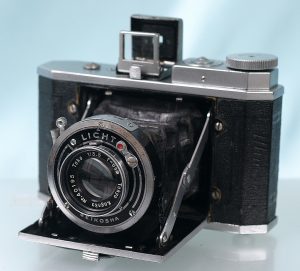
The only other camera made by Tokyo Kogaku prior to the war was the Minion, a horizontally folding strut camera that took 4cm x 5cm images on 127 film. The Minion was much more successful than the Lord as it was made until 1943 and then again shortly after the war.
After Word War II, Tokyo Kogaku would release a 35mm version of the Minion called the Minion 35, and a 6×6 TLR called the Topcoflex. The Topcoflex would be the first time the letters “TOPCO” would be used in any products made by the company, hinting at their eventual change to Topcon.
During my research for this model, I could not find a lot of information about the success of these early cameras, but based on how little info there is, I have to guess they probably weren’t that successful. It is likely that like Nippon Kogaku, Tokyo Kogaku focused most of it’s effort on supplying the Japanese military, but as a result of the de-militarization of Japan after their surrender in the war, the company was forced to grow its portfolio into consumer oriented goods.
Perhaps in an effort to stand out from the crowded medium format and 35mm rangefinder market in Japan, in the mid 1950s Tokyo Kogaku would begin work on their own 35mm SLR camera. The new camera would be released in 1957 and called the Topcon R. It was unique among Japanese cameras in that it used the Exakta Bayonet mount used on Ihagee Exakta cameras. Tokyo Kogaku likely wanted to aim for the top of the market with their new SLR as the Exakta was the preferred SLR choice for professional photographers of the era. There was an abundance of Exakta mount lenses already available for it, allowing for an easy transition from someone who already had an Exakta system and was curious about a Japanese model.
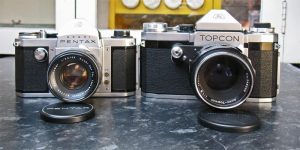
The Topcon R was a robust and heavy camera that was significantly larger than competing models. The image to the right shows a Topcon R side by side with an Asahi Pentax K. Like the Exakta SLR, it used a cloth focal plane shutter, a front mounted shutter release, and had interchangeable viewfinders. The camera was such a success that the company would cease production of all other cameras, and would focus solely on 35mm SLRs from that point.
The Topcon R series would be in production until 1963, receiving two updates in 1960 and 1961. It was also exported to North America as the Beseler Topcon. Other than the name, Beseler and non-Beseler cameras are identical.
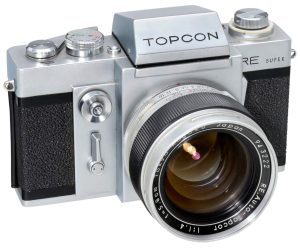
In 1963, Tokyo Kogaku would release a significantly updated model called the Topcon RE Super. The RE Super was the first SLR with through the lens (TTL) metering, beating the Pentax Spotmatic by more than a year. In order to achieve in-body metering, the reflex mirror had a pattern of etched clear lines that allowed 7% of light from the lens to pass through to the CdS meter. This was uncharted territory at the time as every other metered SLR required an accessory, or externally mounted meter. Even the Nikon F, which was already on the market at the time, required the use of a separate viewfinder with a self-contained meter.
In the October 1963 issue of Modern Photography, there was a short article explaining how the meter works in the Topcon. This article references the US export Beseler Topcon, but its the same as the Topcon RE Super here.
The RE Super retained the Exakta mount, but in order to take full advantage of TTL metering with an automatic diaphragm, special Auto Topcor “RE” mount lenses were required. This is important to consider when using one of these cameras that although most Exakta mount and the earlier Topcor R lenses will physically mount to the camera, full functionality cannot be obtained unless using an actual Topcor RE lens.
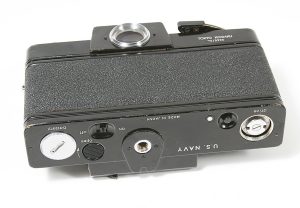
Like it’s predecessor, the RE Super was a physically large camera. It was aimed at the professional photographer and competed directly with Nippon Kogaku’s Nikon F SLR. The RE Super won in a head to head test with the Nikon F performed by the US Navy and Air Force for which camera would be standard military issue. The US Navy and Air Force concluded that the RE Super had a stouter construction and better ergonomics. They preferred the front shutter release and Topcon’s standard 58mm f/1.4 lens, claiming it to be sharper than anything Nippon Kogaku or other German manufacturers were offering at the time. The Topcon RE Super would remain in regular use by the military until the 1980s, well after the camera ceased production.
Topcon branded cameras were sold all over the world, but were also rebadged for different markets. The most common was the Beseler Topcon which was the name given to all Topcon models imported into the United States by the Charles Beseler company. Beseler was mostly known as a maker of enlargers and other photographic equipment, but in the 60s and 70s put their name on various Topcon cameras. Some Topcon models imported to Australia and New Zealand were also sold under the Hanimex name.

When sold in the United States, the Topcon RE Super was called the Beseler Super D and as best as I can tell, was sold here for the same duration as the RE Super. The camera was not cheap. The ad to the left from the January 1964 issue of Modern Photography lists the price of the camera at $369 with the Auto Topcor 58/1.8 lens and $420 with the Auto Topcor 58/1.4. When adjusted for inflation, those prices are comparable to $2943 and $3350 today, making them one of the most expensive cameras of the day.
The RE Super was in production from 1963 – 1972, and was replaced by two nearly identical models, the Topcon Super D (confusingly given the same name as the Beseler Topcon Super D) in 1972, and the Super DM 1973. I could not find any conclusive information about what was changed on these new models other than they came with a newly coated 50mm f/1.4 lens, and the Super DM was only available in black.
Edit (1/25/2018): After posting this article, I was contacted by a Topcon collector named Emil Schildt who told me that the DM had an improved motor drive mount on the bottom of the camera which allowed it to work with a faster electric motor that Topcon had released.
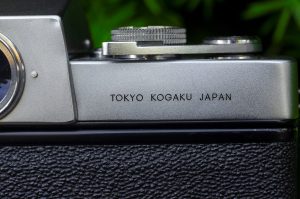
The RE Super and it’s variants were extremely successful for Tokyo Kogaku and created a legion of loyal followers that built their entire portfolio around these cameras and their accessories. Sadly, Tokyo Kogaku would never be able to repeat the success of the RE Super. It is said that they were slow to adopt change. They did not embrace newer technologies and keep up with their competition. The Exakta bayonet mount, although flexible, has a very narrow collar which causes issues with wide angle lenses, and can cause vignetting on macro work. By the time the 1970s came around and cameras were being made that were smaller, faster, and had more electronic conveniences, the Topcon SLRs were considered antiquated.
Although Topcon did have smaller and less expensive “consumer” lines of cameras, they never had the same level of success as their big brothers. Topcon SLRs like the UV series were unable to compete with the growing legion of quality Japanese SLRs made by Nikon, Canon, Minolta, Olympus, Pentax, and several others.
Tokyo Kogaku would attempt to modernize the RE Super in 1977 with two newer models called the RE 200 and RE 300, but it was too little too late. Quality control became an issue, and their reputation as a slow to innovate company basically killed any attempt at a resurgence. Tokyo Kogaku would stop sales of new models in December 1980, but would continue to produce a few models rebadged under different names.

In the years that would follow, the company would continue making specialist optical equipment not directly related to photography, and in 1989 would change it’s name to K.K. Topcon, the name it still has today. A visit to Topcon’s 2018 products website, lists applications for Global Positioning Systems (GPS) and Eye Care industries.
Today, the Topcon R, RE Super, and it’s variants are highly collectible due to their historical significance, unique appearance, and very high quality. From a usability standpoint, there are those who are divided in their appreciation of the RE Super’s bulbous size and ergonomics, but even for those who have no interest in shooting them, they have earned a valuable position in any collection.
Lens Compatibility
The Topcon RE Super in my collection came to me without a lens. When equipped with the correct lens and in good working order, RE Supers go for considerably higher than I would ever consider paying, but I was able to get this body only camera in a lot of other stuff a while back. I was able to sell some of the other things in that lot breaking even to the point where this camera was basically free.
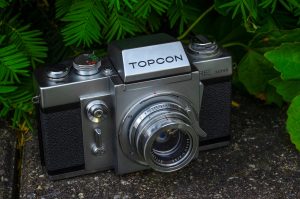
I figured that since it used the Exakta mount and I had some Exakta lenses, I could just shoot it with those. I was aware that I’d run into issues with the automatic diaphragm using a non RE lens, and that I’d have to manually stop down the lens to take a meter reading, and I was OK with that. I can’t remember where, but there was someone online who had said that true Exakta lenses would mount upside down on the RE Super (this turns out to be incorrect). I figured that’s a small price to pay and decided that the best option for a compatible Exakta lens was a Schneider-Kreuznach Xenon 50/2 that I had in my collection.
I chose the Schneider lens for two reasons. The first was that it offered the easiest way of manually stopping down the lens of any Exakta mount lens I had. You simply turned the outer ring to wide open to compose and then stopped it down until the meter showed a correct reading and fired the shutter. My second reason was that I loved the “David and Goliath” look of the extremely small lens mounted to the huge Topcon body. The size disparity was almost hilarious, yet elegant at the same time. Other than seeing the much larger lens mount extending beyond the outer perimeter of the lens, you might actually trick someone into thinking this was a normal lens for this camera!
I dry fired the camera a couple of times after mounting the lens and satisfied that everything was working, I loaded in some film and started shooting. For my first image, I took one of a train more than 100 feet away so I set the lens to infinity, and fired the shutter and…uh oh…the camera jammed. I took the lens off and could see the mirror was partially closed, blocking the viewfinder, and the shutter hadn’t opened yet. I was able to reset the mirror by resetting the shutter with the lens removed and wasting an exposure. Thinking it was a fluke as the camera had performed flawlessly up until this point, I mounted the lens, tried it again and it jammed again, just like it had before.
Frustrated, I rewound the film back into the cassette, being sure to leave the leader out so I could reuse it, and I fired the shutter a few more times. Then I saw my problem.
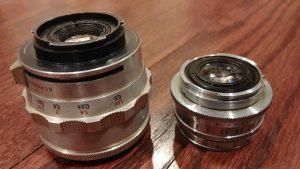
As it turns out, the mirror on the Topcon is very large and comes all the way almost to the very edge of the lens mount. When the Schneider Xenon lens is set to infinity, the inner glass element protrudes slightly into the mirror box. It goes in just enough to interfere with the path of the mirror. The shutter was jamming because the mirror was hitting the lens. Take a look at the image to the right. The lens on the left is an Exakta mount Zeiss Tessar, and the one on the right is the Schneider Xenon. Both are set to infinity. It’s subtle, but notice how the inner lens element extends slightly beyond the mount.
I never noticed this while testing the camera as I must have never had the lens set to infinity. I found that with the lens at anything closer than 15 feet, it was fine, but anything beyond that and it would hit the mirror.
I went home and tried out my 3 other Exakta lenses, a Zeiss Pancolar and Tessar 50mm, and a wide angle Zeiss Flektogon and none of them extended beyond the lens mount. So the lesson learned here is that if you mount a lens to a Topcon that extends into the mirror box at infinity, even a small amount, you’ll have problems. I only mention this as a warning to anyone like me who thinks they can mount any Exakta lens they have to a Topcon and it will work. Most should, but not all.
Note About Topcon UV Lenses: Topcon also had a lineup of interchangeable lenses with a lens mount called the Topcon UV mount which was designed for their leaf shutter SLR cameras that is incompatible with the RE Super. They do not mount, and to my knowledge, no adapter was ever made. Sadly, these UV lenses are far more common than RE lenses, so in the event you encounter one, don’t try to mount it, because it won’t.
Edit 3/31/2023: Thanks to reader Luis Herrero in the comments section below, Luis points out that Tokyo Kogaku did make an adapter so you can mount UV bayonet lenses onto the RE-Super. It is listed as part number 83530 and appears on page 14 of the Topcon catalog on Pacfic Rim’s Reference Library.
My Thoughts
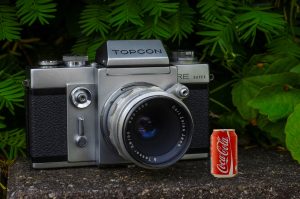
This thing is a monster! If it’s not clear in the image above of a Topcon next to a Spotmatic, here’s another image!
It should come as no surprise that the Topcon RE Super was built to handle extreme duty as it was the camera of choice by the US Navy and other military organizations. Every aspect of this camera has been over-engineered and over-sized. In the spirit of the mockumentary, “This is Spinal Tap”, this camera goes to 11!
When I think back to my favorite SLRs, I tend to prefer cameras that are compact and have excellent ergonomics. The Pentax Sv comes to mind as it was one of the earliest compact SLRs to take ergonomics seriously. The Olympus OM-series has a whole legion of very loyal supporters who champion it’s compact size and excellent ergonomics.
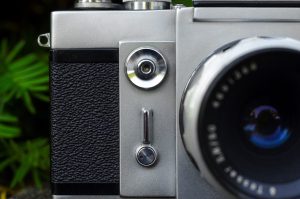
If a compact and lightweight camera with great ergonomics is a desirable trait, then the opposite must be true of a large metal brick whose grip is more akin to “holding onto” than “holding”, as if the camera had a mind of it’s own and you just hold onto for the ride. I’m kidding of course, the Topcon isn’t THAT big, but it is big. Yet, I still found the camera comfortable and pleasant to walk around with. The front shutter release button certainly helps as I find that the front to back squeezing motion of a front trigger is less prone to jarring the camera than a top shutter release.
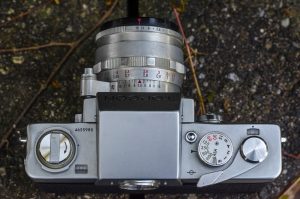
The top plate is large and roomy, which gives an uncluttered look. To the left of the prism is the rewind crank atop a unique bayonet flash hotshoe connector. Like the Nikon F, the flash connector for this camera requires an auxiliary attachment that mounts in this position if you want to mount the flash This was a necessity at the time for cameras with interchangeable viewfinders.
To the right of the viewfinder is the shutter speed selector, with integrated ASA film speed dial, the wind lever, and exposure counter. Pretty straightforward stuff, but there’s a reason this design is straightforward, because it works.

Remove the viewfinder and you have a top down waist level finder with a removable focusing screen. Also like the Nikon F, Tokyo Kogaku had a large number of different focusing screens that could be changed depending on the use for the camera.
It’s not overly obvious from looking at these pictures, but one way in which the Topcon RE is superior to the original Nikon F is that the camera has a built in exposure meter that works with any viewfinder. The meter readout is in the little window between the rewind crank and viewing screen, and if you look on the left side of the opening where the viewfinder goes, there is a little window that reflects the match needle display into the viewfinder when it is mounted.
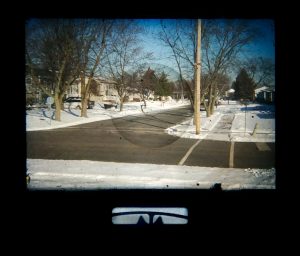
The view through the standard prism viewfinder is very large and bright and shows the match needle readout at the bottom. This is one way in which the large size of the entire camera proves to be a big asset. Big camera = Big viewfinder. The brightness of the viewing screen, while not as bright as those from the 80s and 90s, is still very good, and likely was a huge selling point to customers when this camera was a current model.

Flip over the camera and you see a few interesting bits. The image to the left was shot with the camera upside down, so in the image from left to right, I’ll start with the battery compartment which houses the single PX625 battery. Although this camera was designed for 1.35v mercury batteries, I found that the meter was still spot on with a modern 1.5v battery which suggests some type of bridge circuit which stabilizes the voltage. The circular battery door has a deep textured pattern around the rim which allows you to open it with your fingers. A typical coin slot is also available in the event you need some extra leverage.
Next to the battery compartment is one of the more unique door releases I’ve seen on a camera. To open the film back door, you press in on the door release while simultaneously making a twisting motion with your thumb. I found this to work quite well and allows you to open the back of the camera with a flash still attached to the camera. Next to the door release is the power switch for the meter. Although acceptable for the time, I have never liked cameras where the meter had it’s own power switch. I like cameras where the meter either powers down automatically after a period of disuse, or is activated by some other touch point on the camera (wind lever, shutter release, etc). The user’s manual suggests that the camera need not be turned off every time the camera is put away as drainage from the meter is negligible as long as you use a lens cap.
In the middle of the bottom plate is the tripod socket with an extended plate which helps to stabilize the camera when placed down on a table with a lens mounted. Next to the tripod socket are the rewind release button and the motor drive connector. The Topcon had a electric motor drive available which allowed for up to 3 frames per second and auxiliary battery packs which could be mounted here, allowing for extended use in the field. Like the battery cover, this cover also has both a textured pattern and a coin slot to make it easier to remove.
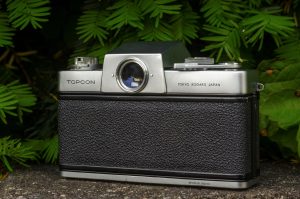
The back of the camera has no controls other than the round viewfinder which is threaded for a variety of viewfinder accessories like corrective diopters, right angle viewfinders, and magnification viewfinders. The TOPCON logo along with the company name “Tokyo Kogaku Japan” is prominently displayed here, just in case you forget whose camera you are using.
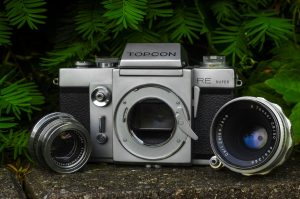
From the font of the camera we have the already mentioned front shutter release which is threaded for a cable release and beneath it, and a really elegantly designed mechanical self timer.
Since the Topcon uses an Exakta bayonet mount, the lens detaches much in the same way as any Exakta lens. There is a swiveling catch to the right of the shutter mount which must be pressed in order to remove the lens. As I mention earlier in this review, all Exakta mount lenses will physically mount to the Topcon RE Super, but not all will clear the mirror.
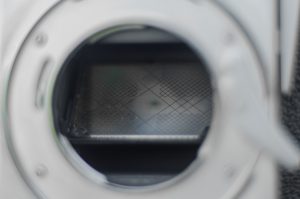
A look inside of the mirror box reveals the reflex mirror with an intricately designed pattern in the reflective surface which was designed to allow 7% of the light to pass through the mirror to hit the exposure meter while the mirror is still down. This is similar to the system used by Canon with their Pellix cameras, except the mirror in the Topcon still flips up and down.
I told myself when I was shooting this camera that I shouldn’t compare it to the Nikon F, even though that was it’s most logical competitor. The two cameras share quite a bit of similarities, were both endorsed by various military organizations, both catered to professional photographers, and both had a dizzying array of accessories.
Since I said I wouldn’t directly compare the two, I also didn’t type up the following table:
| Topcon RE Super | Nikon F | Winner | |
| Build Quality | Built like a tank. | Built like a tank. | Tie |
| Lens Mount / Availability | While Exakta mount lenses can be used on the RE Super, they lose some functionality. Genuine Topcon RE lenses are optically as good as Nikkor lenses, but are far less common and more expensive today. The narrow collar of the Exakta mount causes problems with macro and wide angle lenses. | Nikon has the longest lasting lineup of lenses ever made, and while there was no way to know this back then, we now know the answer. There are far more Nikon F-mount lenses than Topcon. The larger Nikon F-mount collar allowed for extremely wide angle and macro lenses to be used without compromise. | Nikon F |
| Shutter | Speeds 1-1/1000 + B, cloth curtain | Speeds 1-1/1000 + B, titanium curtain | Nikon F |
| Viewfinder | Interchangeable, bright and easy to use with prescription glasses. | Interchangeable, bright and easy to use with prescription glasses. | Tie |
| Accessories | I didn’t bother to count how many individual accessories were made, but there’s a lot, and at least one for pretty much anything anyone would ever need. | The Nikon F system has a dizzying array of accessories, probably more than anyone has ever counted. While Nikon probably has more, the Topcon has at least one from each category of every pro accessory. | Tie |
| Exposure Meter | In-body CdS meter with behind the mirror metering. | The in-body meter wasn’t available until the F2, so your only option was to use a prism meter. | Topcon |
| Ergonomics | Easy to use, evenly spaced controls with a front shutter release. | The Nikon F cemented the location of the controls for pretty much every SLR ever. | Topcon (but only because I really love front shutter releases.) |
| Film Loading | Hinged rear door, removable for interchangeable backs. | No hinge, removable for interchangeable backs. | Topcon |
| Refinement | The smoothest film advance on a 35mm SLR I’ve ever experienced. Finely machined battery and motor drive covers. Easy access to viewfinder detach button and smooth insertion of new viewfinder. | Putting on my flame suit here, but the Nikon F is more utilitarian, offering less “tactile” refinements than the Topcon. This is highly subjective I know, but the Topcon “feels” like a more upscale camera. | Topcon |
| Overall | See Below |
Okay, okay, I did it. I compared the Topcon RE Super to the Nikon F which is arguably one of the most successful and historically significant cameras ever made.
Yes, there are a few areas in which I believe the Topcon has an edge on the Nikon and there are others where Nikon is tops, but it’s pointless to declare one to be superior to the other. In fact, I would say that the winner is YOU since you no longer have to choose! Prices are so low today that you can buy each of these cameras with a lens for a very small fraction of the price these things originally sold for. There’s no point in picking a winner when you can have both!
All joking aside, the Topcon RE Super is an outstanding camera with a unique look, incredible build quality, and a list of features that makes it comparable to one of the best cameras ever made. If I had one conclusive thing I can say in favor of the Topcon is that because they’re far less common than the Nikon F, they’re a bit more interesting to the collector, simply because they are different.
My Results
Since acquiring this camera, I have never had access to a genuine Topcon RE lens. I would periodically check online auctions for the correct lenses, and they consistently sold for way more than I wanted to pay. Since I already had a nice collection of Exakta lenses, I made the decision to use one of those and accept the limitations of the Exakta lens and shoot it.
Edit (2/9/2019): Since completing this review in January 2018, I finally came across a genuine RE.Auto Topcor 50mm f/1.8 lens. Although I am keeping the gallery of images I originally shot using the Tessar Exakta lens, I am including a second gallery after showing my results from the new lens.
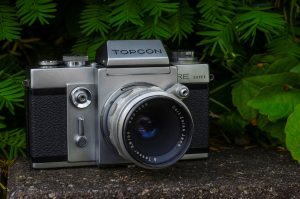
I mention earlier in this article that using a genuine Exakta lens on a Topcon requires stop down metering, I didn’t find that it negatively affected the experience much. I have had to use stop down metering on other cameras before, so it was a compromise I was willing to accept in order to test the camera while using the meter.
I loaded in a roll of fresh Fuji 200 and went shooting. For the majority of the roll, I used a Zeiss Tessar 50/2.8 lens, but for a few I tried out a Zeiss Flektogon 35/2.8 wide angle. The Flektogon had severe internal haze that I was sure would show up in the images, but I wanted to try it out anyway. Try to guess which of the images below was shot with it.
I’ll skip any talk of the sharpness or color accuracy of the images as those are more indicative of the Zeiss lens that I used, but in terms of exposure, I was very impressed. The exposure meter in this 50+ year old camera has clearly not lost a step and not even using an incorrect voltage battery threw it off. I knew it was a risk to base my exposure measurements entirely on an untested camera, but it proved to be a smart choice. Not even using stop down metering gave me trouble, even in difficult lighting situations such as an abandoned house, inside of a train, and in high contrast situations.
I have no idea if I am just lucky, or if other Topcon RE Supers would be just as accurate, but from this one experience, I thought the camera performed exceedingly well.
The images below were all shot in the summer of 2018, after this review was originally posted, but with the RE.Auto Topcor lens attached.
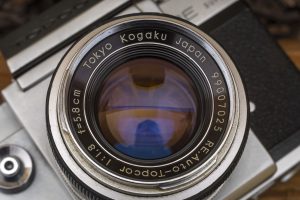
From a usability standpoint, I loved the experience with the Topcon. This camera really surprised me as when I first got it, I laughed at it’s huge size and pronounced, almost brick like dimensions. Of all the things that could have been a challenge in using the camera (size, lens, weight, age) none proved to be an issue.
I am extremely pleased with the images I got from this roll and I look forward to shooting with it again. The only downside though is that now I REALLY want a genuine Topcon RE lens!
If you have an opportunity to pick up one of these gorgeous cameras, I absolutely recommend it. It may be big, and it may look awkward when you first see it, but once you give it a chance, you’ll find that any negative impressions you have of it will quickly disappear.
Related Posts You Might Enjoy
External Links
http://camera-wiki.org/wiki/Topcon_RE_Super
https://en.wikipedia.org/wiki/Topcon_RE_Super
https://www.shutterbug.com/content/topcon-re-super-first-35mm-slr-ttl-metering
https://www.photo.net/discuss/threads/topcon-super-d-re-super.270498/
https://www.photojournal.it/topcon-la-prima-nella-corsa-allesposizione-ttl/ (in Italian)


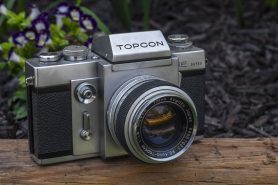
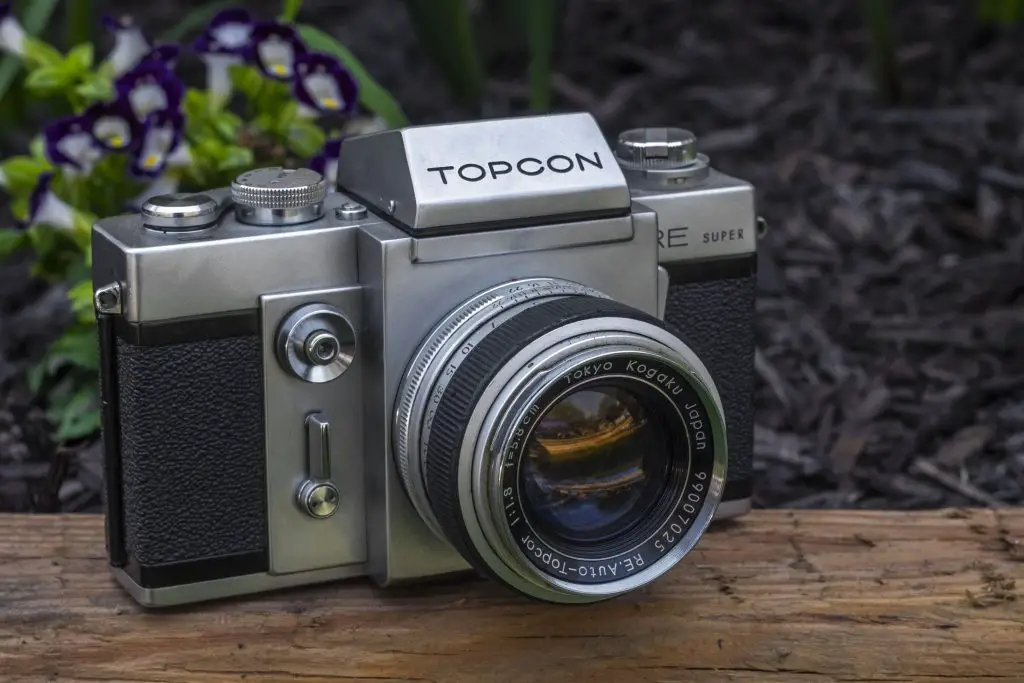
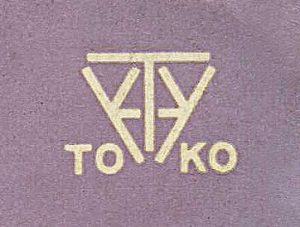




















TOPCON MIRROR HITS LENS: 1) get an additional Topcon mirror; 2) get a lens that interferes with the mirror; 3) take them both to a jeweler who will trim the mirror to just by-pass the lens (the small portion of the mirror that was removed does NOT effect viewfinder or meter).
Cost for trim? $35. Worked well for me.
An easier way: use a lens extender..
Is there anyone that replaces Exakta VX IIa cloth shutters? I love my Exakta but not the pinholes.
Best place for replacing the shutter and for getting a cla on an Exakta is Blattworld in NY. ( [email protected] ). They have the shutter curtains in stock. Make sure you have the right address because they have moved from 34 Franklen Ave location. Another place is Key Camera Service in Longmont CO.
Last I knew Houston Camera made Exakta repairs. They replaced my cloth shutter on a well used VX. But that was over 15 years ago. Still works. I was in Texas for a week and they had it done
in 3 days. Still love the camera. David
FYI, Dave’s Camera Repair in Chelsea Michigan is a top contender for Topcon repair. Dave worked for an authorized Topcon dealer in the 60s/70s and has extensive experience with the cameras. He also has a treasure trove of new old stock parts. I picked up a Super D for the cost of a bar tab, and then sent it to Dave for an overhaul. I ended up with a completely overhauled camera with a majority of new parts and a meter adjusted for silver oxide batteries for about $50 less than a working Topcon on eBay. Only problem is that my RE 1.8 lens has significant cleaning scratches and RE lenses have doubled in price in the last six months.
Thanks for the tip, Anthony. It’s always good to consider a properly serviced camera from an expert, and you’re right, the cost isn’t as high as some people think!
I still regard my Topcon RE as my favorite camera. The original one is in need of a tune-up but over the years I have purchase several more including D and DM versions. I have them set up on the ready with different lens options so I can grab and go at will. Your battery conversion is interesting, it is getting harder to find the PX-13 or 625 series coin batteries. If you or Dave have some info on this process please post it. Thank you.
David C.
Love the post Mike, and the camera. Only this afternoon I scored a 35mm f2.8, for $105 AU. Could not
believe my luck!
Nice pickup! I’ve noticed that all of the RE lenses demand higher prices than typical SLR lenses of the era. I once tried to score a wide angle RE lens and it went for $250!
Hi. I have two of these RE Supers. I had one overhauled and it was working fine. Then I tried an RE Auto Topcor 25mm 3.5 lens on it. This lens is a retro-focus lens with tiny bayonet-mount filters on the rear element. The first time I tried it, the shutter jammed and the mirror is stuck. I can’t understand why this would happen, especially since this lens was specifically made for this camera. I removed the lens, but the stuck mirror is still a problem. I see from a comment above that someone in Chelsea, MI specializes in Topcon repair. I’m about 40 minutes’ drive from there, so perhaps I’ll contact him. great article!
I had the same issue with a Schneider lens in Exakta mount. It would hit the mirror when the lens was focused to infinity. I just stopped using that lens, but if you want your camera repaired, the guy you are thinking of is Dave’s Camera Repair. I’ve heard he bought out the remaining supply of Topcon parts from the factory years ago. He would be a good person to have look at your camera.
What I find interesting about my issue, is that the 25mm Topcor I have was made specifically for use on the RE Super/Duper D. Therefore, it shouldn’t have caused any issue with the mirror or shutter.
It definitely should not have caused a problem. My issue with the Schneider Xenon lens is that it was made specifically for the Exakta, before the Topcon existed, so I could understand there being an interference issue. But using a wide angle Topcon RE lens on a Topcon RE should not be an issue. Your camera or lens needs to be serviced.
I have the Topcon Super DM and never had a problem with the 25mm wide angle Topcor lens. I never tried it on my Topcon RE Super and can’t tell you if this lens was hit by the mirror. The advantage of the Topcon Super DM is that it has mirror lock-up, the RE Super does not.
I have several REs and DMs and the same type lens and never experienced that proplem. Please keep us posted on your findings
I am interested in what caused the mirror lockup issue. Thanks Davie C
Update on the best place to replace shutters on Exakta Cameras..
Camera Repair Service
433 Market Street
Pittsburgh, PA 15222
Phone: 412.261.5225 Fax: 412.261.7616
Email: [email protected]
They also Cla’d my Topcon Super Dm and moderized the light meter so it could take today’s batteries. They also moderized my Nikon Photonic light meter as well.
Thanks for the info, John!
This review of the Topcon RE Super takes me back to the early 1960’s. when my father asked a then-active-duty U.S. Navy officer to buy a 35mm SLR when he passed through Japan. He presented my father with a Topcon RE Super, saying that it had a built-in light meter, unlike Nikon’s add-on Photomic meter head. This was state of the art back then, though I didn’t know it at the time.
Having used Ye Olde Family Leica IIIa, being able to focus down to 18 inches was revolutionary, since rangefinder cameras didn’t focus closer than 3.5 feet. Using the exposure meter was interesting, though I did find the ASA 400 lockout at 1/8 sec, troubling for low light metering readings.
Time marched on, and I looked around for other Topcon lenses, which were either unavailable or “mail order only from NYC.” I looked at the Preset R Topcors, especially the 300mm f/2.8, since a 200mm f/5.6 RE Topcor was pedestrian at best. Eventually, I bought an 87-205mm f/4.7 Topcon Zoom ;lens and discovered the “close-up” lens in the top of the lens case that got me closer than 6 feet to a subject. (I’ve since learned that was a Sun Optical design, which was a top performer.;) By this time, I was using Shutterbug Ads to find Topcon lenses, since the 25mm f/3.5 lTopcon was hard to find, even through NYC maile order companies. I ran into the same mirror problem, but a local camera repairman sorted out that problem.
By this 1970’s, the RE Super developed frame spacing problems, and the Nikkormat FTN was s less bulky option. I set it aside, since Soligor and Vivitar lense were available for Nikon, but not always for Topcon. I think it’s in storage, along with the Brownie Target Six Twenty, a memory of film camera technology of the past. Topcon was more a state of mind, photographically speaking.
This is a great story Patrick! Thank you for sharing it! I always love hearing these “first person perspective” recounts of some of these cameras when they were new. For me, coming into this hobby when I did, all of these models are old, so hearing your experiences of what it was like to use them when they were new are fascinating and definitely add to their history.
This is the best, most comprehensive review of these cameras I’ve ever read. The perspective is very well balanced, especially your comments on the use of the Exakta bayonet mount. When it was implemented, it was a sound decision, Exakta being the preferred camera for pros at that time. The demise of the RE (and its “sister” cameras) was due to a variety of reasons, especially when Tokyo Kogaku stopped innovating. I originally bought my RE so that I could use my Carl Zeiss Exakta-mount lenses with a superior camera to my aging Exakta VX and not-particularly-well-made RTL. I fell in love with the feel, durability, and well-engineered function of the RE. Even though my other (current) favorite camera is my Olympus OM-4, I love the RE just as much, even though it’s ⅓ larger. You’re right – it’s big and heavy, but never feels unwieldy; it simply feels elegant, and that’s what it is – an extremely elegant camera. I recently acquired a Topcor 58mm f1.4 and it’s amazing. The only downside to all of this is that a couple of Exakta-mount lenes won’t mount. My Zeiss Flektogon 20mm f4 won’t mount, nor will my Meyer 30mm Lydith. I’ve yet to discern why – anyone have any ideas about this? The rest of my Exakta-mount lenses, even the Angenieux 35mm and the Zeiss 35mm Flektogon go on without hesitation, so I’d love to hear any thoughts about this. Thanks again for the great article!
Doug, thanks for the compliments. Your additional experiences with other Exakta lenses that don’t mount correctly is interesting. I would love to see a compatibility database showing which ones fit and which don’t, but sadly, I don’t have that many unique lenses. The Schneider one I speak of in the article is the only one I’ve come across with issues. The Tessar and Biotar lenses I have work fine.
Mike, I went ahead and made a complete list of Exakta-mount lenses I have that mount on the Topcon, and those that don’t. The ones that do: Schneider Kreuznach 135mm f3.5; Tele-Kalimar (Berlin) 250mm f5.5; Zeiss Pancolor 50mm f1.8; Meyer Oreston 50mm f1.8; Angenieux 35mm f2.5; Zeiss Flektogon 35mm f2.8. In addition to the 20mm Zeiss Flektogon and the 30mm Meyer Lydith mentioned in my previous post, the other lenses that won’t mount are the Meyer Orestegor 300mm f4 and the Zeiss Pancolor 50mm f2.0. It’s interesting that the original Pancolor (f2.0) won’t, while the newer Pancolor f1.8 (developed to be used with the newer Pentacon Exaktas and Prakticas of the early 70s) fits beautifully. Some of these Exakta-mount lenses have the shutter coupling arm, others do not. It doesn’t make any difference – the 35mm Flektogon fits perfectly while the 50mm f2.0 Pancolor does not. I still haven’t been able to identify what is preventing these seemingly identical-mount lenses from mounting, but they just won’t rotate and click onto the lens locking/release lever. I can’t see what the problem is by looking at the lens itself – the problem must be something in the camera mount itself, and I’m really not wanting to remove it at this point. I’m curious, but not THAT curious, heh-heh. Again, I’d love to hear from anyone who has some info to share on this.
Update: The Meyer 30mm Lydith will mount; it just requires a firm push and twist. This is a fine lens and I’m pleased it’s working out. However, the 20mm Zeiss Flektogon remains resistant to mounting. It looks like what is preventing it from mounting is a small bulging fitting on the backside of the shutter arm. The 35mm Flektogon also has this arm, but the backside is smooth and it goes on easily. The 20mm not mounting this camera is a real drag, because it’s one of the coolest lenses ever made by Carl Zeiss. There is virtually no linear distortion making it a superb architectural lens, At least the Lydith now works. Cheers!
You have a great site. I was looking for some information as to where I could sell my Topcom and three lenses or what they were going for. My camera was purchased in RVN in 1966 or 1969. It was a very good camera until I switched to Nikon.
Hi, Mike
Regarding the paragraph dedicated to Topcor UV lenses (Note About Topcon UV Lenses), there is an adapter for these lenses (built by Topcon itself) to the RE mount of the Super D (see page 14 of https://pacificrimcamera .com/rl/01180/01180.pdf )
I don’t know if this has been addressed in any of the previous comments, but in a light review I haven’t seen it.
Luis
Hi, Mike,
In relation to your “Note About Topcon UV lenses” where it is stated that there is no UV to RE Super D adapter, I believe that Topcon itself made such an adapter, as can be seen in the Topcon catalog ( https://pacificrimcamera. com/rl/01180/01180.pdf ) on page 14.
Regards,
Thanks Luis, I definitely did not know this. I have updated the review with your find and given you credit!
I’m glad to help improve your excellent site
Greetings
Hi there,
Re-listening to your episode 36 I realized that there is still some confusion about the Super DM autowinder versus the motor drive.
All the Super D, RE Super and Super DM bodies had the Topcon motor drive connection on the base plate. The motor drive is a beast and allowed you to use the 250 frame back at up to 3 frames per second, had NiCad batteries, various power supplies and a radio control trigger available.
The difference with the Super DM is that Topcon added an electrical contact on the base plate for their new auto winder. The auto winder only advanced one frame at a time when you pressed the shutter release. As a matter of fact, the photo of the US Navy camera you show on your RE Super review is most likely a Super DM and right next to the rewind button on the base plate you can see the electrical contact for the Topcon auto winder.
Super DMs are great but the wind-on action is not as nice as the RE Super, still very robust but not as smooth. The Super DM has some other differences but nothing earth shattering.
One other thing, once the Super DM with the auto winder was released you could have the bottom plate electrical contact retrofitted to the Super D and RE Super bodies, you see some out there occasionally.
Thanks for all the great camera talk. I have listened to everyone of your episodes, some multiple times.
Mike,
Amazing article from one writer to another. Tha electrical meter schematic on page 109 was cutoff and you didn’t indicate which source was the source, where is page 110? Can you tell me? Nikons,s in body open aperature ttl meter was first used in the F3, due too a 10 year patent held by Topcon / Toshiba. F2 used ttl in removeable prism meter heads. Nikon sucess was due to heavy advertising by EPOI , a major recession case by Arab oil embargo of 1973, and last but not least; a song , “Kodachrome” by P. Simon . Causing a number of SLR camera manufacturers to file for bankruptcies. Topcon survived but was heading for the rocks with its UV lens and camera design. Thanks, Don
Don, thanks for the kind words. The scan of page 109 from that issue continues onto 110 and the image is right next to it. Here is a direct link to the rest of the article. The reason it looks different is the page was cropped to only contain the relevant part about the Topcon. That page also shared content with something unrelated, which was omitted. The guy who did the scan, Marc Bergman, passed away in 2021, so I no longer have access to the original scans.
https://mikeeckman.com/wp-content/uploads/2018/01/TopconMeter2.jpg
Great review! Very tempted to go down the Topcon RE rabbit hole… The sample shots, especially the flowers, the boy and the train shots, were they with the Zeiss Flektogon 35/2.8?
I have a Canon F1, NF1, Nikon F2… LX… like i need ANOTHER Camera system. GAS is real….